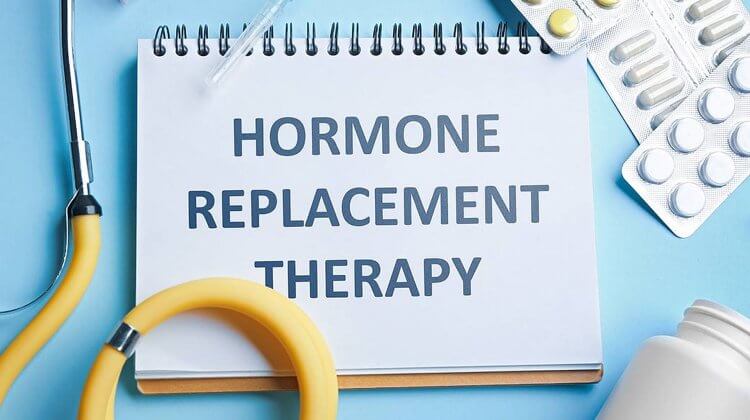
In this two part series, I will be giving an overview of my approach to hormone replacement therapy. I call my approach “hormone balancing”, which is based on the principles of keeping your sex hormones (testosterone, estrogen, and progesterone) at the same levels that they were at in your mid-twenties. In addition to sex hormones, I also occasionally focus on balancing growth hormone and IGF-1 levels as well.
For men, hormone balancing usually means adjusting the testosterone/estrogen ratio. As men get older, their testosterone levels tend to slowly decline while their estrogen levels actually increase. These slow “demasculination” of men with age has numerous negative consequences, including but not limited to fatigue, fat gain, muscle loss, insulin/diabetes, gynecomastia, and prostate enlargement.
If a male patient requests to go on a hormone-balancing program, he first has to go through a series of examinations as well as give me his medical history so I can properly determine why his sex hormones are out of balance. A comprehensive hormone panel is taken to measure blood levels of free and total testosterone, estradiol, total estrogens, luteinizing hormone, IGF-1, prolactin, DHEA, and several other hormones. In addition, numerous screening for different forms of cancer are looked at as well, including a rectal exam and prostate specific antigen – a useful marker for prostate cancer. When the results of the tests come in, I then determine whether or not the patient is a good candidate for hormone replacement therapy. While I won’t go into all the details, the main criteria for going on a hormone-balancing program include:
1). Patient has a measured sex hormone deficiency or imbalance based on their blood tests. Salivary tests are sometimes useful as well for some complex cases.
2). Patient does not show any signs of cancers that may be affected by a hormone-balancing program.
3). Patient exhibits clinical features of sex hormone imbalance: low sex drive and sexual function, low self esteem, depression, irritability, fatigue, inability to gain muscle, weak bones loss of heights, shrinkage of the penis and testicles, and other symptoms.
If these criteria are met, I then work with the patient on a case-by-case basis. Personalized programs are set up to determine the best treatment options for hormone balancing. Even though many patients request immediately to be put on testosterone replacement therapy immediately, I usually suggest other options first. Unlike women whose sex hormone production almost completely shuts down after menopause, male “andropause” is a slow process where free testosterone levels ever so slowly start to decline. Putting a man on testosterone replacement therapy could potentially shut down his sex hormone production completely, especially if supraphysiological (higher than normal) testosterone levels are maintained. It might take as long as six to nine months for his sex hormone production to return to normal after going off of testosterone replacement therapy. Men who insist on testosterone replacement therapy may find that they need to stay on it the rest of their life. Testosterone replacement therapy can also lead to lowered sperm counts, sleep apnea, increased red cell mass, and water retention. For these reasons, I have a whole arsenal of options for balancing your hormone levels.
Treatment Options for Hormone Balancing
Aromatase Inhibitors
This class of drugs is one of the safest and most effective tools for hormone balancing. As mentioned above, one of the most common problems of aging for men is the decrease in testosterone levels and increase in estrogen levels. Part of the cause of this phenomena is the increase of blood levels of aromatase, the enzyme responsible for converting testosterone to estrogen. Arimidex is the first and most commonly prescribed drug that inhibits the aromatase enzyme. This drug is highly effective, and in some cases can restore a youthful testosterone/estrogen ratio in a matter of days. The key to using this drug is finding the right dosing pattern, as you don’t want to reduce estrogen levels too much as having too little estrogen for long periods of time can lead to fatigue and loss of libido, decreased coronary vessel dilation, lowered HDL cholesterol levels, as well as osteoporosis.
One advantage of using Arimidex to boost testosterone rather than simply prescribe testosterone itself is that Arimidex does not shut down your body’s natural production of testosterone. In fact, Arimidex may actually increase your body’s release of luteinizing hormone from the pituitary gland. Luteinizing hormone is the main hormone responsible for signaling your testes to produce more testosterone. Unlike testosterone replacement therapy, a man can stop taking Arimidex and have his hormones back to previous levels within days.
The main disadvantage to Arimidex is that it is highly expensive at around six dollars per tablet. Since it was approved by the FDA, strictly as a drug for women with breast cancer, men might have some trouble getting their insurance company to cover the cost. Fortunately, Arimidex is potent enough that it can be effective in doses as little as ¼ tablet per day.
Two new aromatase inhibiting drugs, Femara and Aromasin, have come out recently that may prove to be more cost effective than Arimidex. The promotional literature on Aromasin says that it is more effective than other aromatase inhibitors because it permanently binds to the aromatase enzyme, whereas Arimidex only temporarily binds to the aromatase enzyme. In simple English, this means that Aromasin should be more potent and longer acting than Arimidex. Since Aromasin’s cost is almost exactly the same as Arimidex but is potentially more potent, it could turn out to be the more cost effective option. However, the Aromasin promotional literature is quick to point out that “the clinical relevance of these differences in mechanism of action has not been established.”
Prohormones
I often use oral or sublingual doses of the prohormones androstenedione (adione) and 4-androstenediol (4-adiol) as a mild and temporary form of hormone replacement therapy. This is a highly safe method since these prohormones cause a temporary spike in testosterone that does not have much effect on your body’s natural testosterone production. While 4-adiol is more potent at boosting testosterone, some men get more of a brain/stimulant effect from adione. This may be due to adione’s conversion to estrogen, as estrogen may have more of a stimulant and libido effect in men than in women. For more on the effects of estrogen on the brain, read Pat Arnold’s article “Psychological and Sexual Actions of Androgens”.
Speaking of Pat Arnold, I am very interested in his latest prohormone 5alpha-androst-1-en-3,17-dione (1-AD for short). One of my patients reported very large muscle gains while using 1-AD, and this patient is an experienced personal trainer and bodybuilder who is already very large and muscular. However, it is not only 1-AD’s use as an athletic performance enhancer that interest me. 1-AD is also a potent androgen that cannot convert to estrogen. This might make it a useful supplement for men with low testosterone levels and high estrogen levels. Since testosterone can convert intensively to estrogen in some older men, putting men on testosterone replacement therapy might be largely ineffective for restoring a proper testosterone/estrogen ratio. 1-AD may be a good alternative to testosterone in that it may have many of the same effects on improving mood, energy, and libido as testosterone without conversion to estrogen. Of course, I cannot recommend it yet as an anti-aging supplement until there I get more feedback from patients and see more clinical studies. But it does look promising!
Transdermal Testosterone
For men who do not get good results with aromatase inhibitors or with prohormones, it may be necessary to put them on testosterone pulse therapy (using testosterone only two or three times a day) or continuous testosterone replacement therapy. In my opinion, the best option for testosterone replacement therapy is the new FDA approved drug AndroGel. AndroGel is a transdermal testosterone gel that gives your body a slow, even level of testosterone throughout the day. It is easy to use, as you simply put a small amount on your skin (about the size of a ketchup pack) with no uncomfortable patches or injections. Many insurance companies will cover the cost of AndroGel if medical necessity is established. Since AndroGel only brings your testosterone levels up to a normal range, it is generally a safe and mild treatment option. Studies have shown minimal side effects and only mild shut down of natural testosterone production (1).
A couple of companies have come out with transdermal prohormone products. These products have 4-adiol mixed in an alcohol spray. Users of these products spray the alcohol on their skin. Keep in mind that the suggested doses of these products may boost your testosterone levels much higher than AndroGel. The recommended dose of AndroGel is only fifty to one-hundred milligrams per day, while the prohormone sprays list the upper range of doses as high as 800 milligrams per day. If you are using these sprays for hormone replacement, rather than bodybuilding, a much smaller dose would be appropriate.
These sprays may be a good option for many men because 4-adiol is effective at boosting testosterone levels but does not seem to increase estrogen levels as shown in a study by Tim Ziegenfuss (2), as well as in-house research by two supplement companies. Men with high estrogen levels who have not responded well to other treatments might want to consider smaller doses (50 to 200 milligrams per day) of 4-adiol sprays.
Human Growth Hormone (hGH)
While hGH is the darling of the media in terms of hormone replacement therapy, I generally only prescribe it to select patients with very low hGH levels who have not responded well to other treatments and show pituitary deficiency of hGH production. The reason for this is that hGH is very expensive and requires daily injections that many people find inconvenient. HGH simply does not have the “bang for the buck” that testosterone and other treatments have for putting on lean mass and improving sex drive. To be fair, in some patients hGH can have pronounced effects on energy levels and depression. HGH often improves sleep quality and puts patients in a good even keeled mood. However, these are patients who have been pre-screened and shown to have a major growth hormone deficiency.
Side Effects of Testosterone
Testosterone has been blamed for a wide variety of problems, from heart disease to prostate enlargement to hair loss. It is interesting that these problems don’t occur to men in their early teens when their testosterone levels are at their peak, but rather in their old age when their testosterone levels are very low and their estrogen levels are very high. In fact, estrogen is now believed by many doctors and scientists to be the bigger culprit in causing prostate problems in men than testosterone (3, 4, 5). Estrogen may also be a culprit in male pattern baldness as well. Long-term studies on Androgel have confirmed the safety of testosterone replacement therapy, at least in men with testosterone deficiencies (1). I believe using prohormones and/or aromatase inhibitors is even more- safe than testosterone replacement therarpy.
In spite of the positive safety profile of testosterone, I still take numerous precautions with patients on testosterone replacement therapy. Prostate specific antigen is measured regularly along with digital rectal exams, and I also put my patients on a blend of prostate protecting supplements including saw palmetto, quercetin, and lycopene. These supplements may help prevent prostate enlargement and inflammation, and may help prevent prostate cancer as well.
I also do not believe that natural testosterone is a risk factor for heart disease either. Studies on testosterone have shown that even large doses do not lower HDL (“good”) cholesterol levels or raise LDL (“bad”) cholesterol levels (6). Other anabolic steroids such as Winstrol or nandrolone lower HDL-C levels a lot, but not testosterone.
I believe future research will show that testosterone may actually reduce the risk of heart disease in some groups of men. One mechanism where testosterone may reduce heart disease risk is by lowering abdominal fat. Many older men are skinny in most of their body except for a large deposit of fat around their abs. This is not surprising, as a couple of recent studies have linked lower testosterone levels ( and higher estrogen levels) to increased abdominal fat (7,8). It is well established that estrogen increases fat storage, as it is commonly given to livestock to fatten them up. However, testosterone role in fat loss is not so well understood. It was previously believed that testosterone reduced body fat indirectly by increasing muscle mass, thus boosting your body’s caloric needs. However, new research linking testosterone to fat loss has lead me to believe that testosterone has direct effects on mobilizing abdominal fat. Research has already shown that androgens can mobilize lower body fat in women (9), so it seems highly likely that testosterone can also mobilize body fat in men as well. If testosterone can help keep a man lean, muscular, and fit into his old age, it almost certainly will reduce his risk of heart disease.
Conclusion
Hormone balancing can have powerful anti-aging effects if the proper treatments are used. I have seen men about to retire from their jobs due to fatigue find a new lease on life and sexuality once they properly restore youthful sex hormone levels. The key, of course, is finding the right treatment option. I would advise any man suffering from fatigue, loss of libido, and loss of muscle mass to have their hormone levels checked and consider many of the different treatment options outlined in this article.
References
1. Swerdloff, RS, and Wang, C., et al., Long-term pharmacokinetics of transdermal testosterone gel in hypogonadal men., J Clin Endocrinol Metab. 2000 Dec;85(12):4500-10.
2. Ziegenfuss, TN, et al., Safety and efficacy of prohormone administration in men, presented at American Society of Exercise Physiologists 2nd Annual Meeting, 1999
3. Suzuki, K, et al., Endocrine environment of benign prostatic hyperplasia: prostate size and volume are correlated with serum estrogen concentration, Scandanavian Journal of Urology and Nephrology, 1995; 29: 65-68
4. Gann, P.H., et al., A prospective study of plasma hormone levels, nonhormonal factors, and development of benign prostatic hyperplasia
5. Carter, H.B., et al., Longitudinal evaluation of serum androgen levels in men with and without prostate cancer, The Prostate, 1995;27:25-31
6. Zgliczynski, S, et al., .Effect of testosterone replacement therapy on lipids and lipoproteins in hypogonadal and elderly men. Atherosclerosis. 1996 Mar;121(1):35-43.
7. Tsai, EC, et al., Low serum testosterone level as a predictor of increased visceral fat in Japanese-American men. Int J Obes Relat Metab Disord. 2000 Apr;24(4):485-91.
8. Jankowska, EA, et al., Relationships between age-related changes of sex steroids,
obesity and body fat distribution among healthy Polish males. Med Sci Monit. 2000 Nov-Dec;6(6):1159-64.
9. Lovejoy, et al, Exogenous androgens influence body composition and regional body fat distribution in obese postmenopausal women—a clinical research center study, J Clin Endocrinol Metab. 1996 Jun;81(6):2198-203
About the author
Warning: Undefined array key "display_name" in /home/thinksteroids/public_html/wp-content/plugins/molongui-authorship-pro/includes/hooks/author/box/data.php on line 11
Warning: Undefined array key "display_name" in /home/thinksteroids/public_html/wp-content/plugins/molongui-authorship-pro/includes/hooks/author/box/data.php on line 11
Warning: Undefined variable $show_related in /home/thinksteroids/public_html/wp-content/plugins/molongui-authorship/views/author-box/parts/html-tabs.php on line 30


No replies yet
Loading new replies...
Join the full discussion at the MESO-Rx →